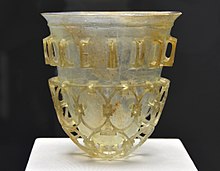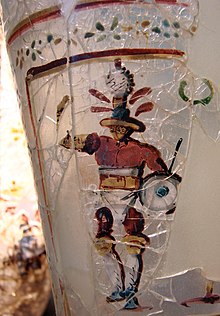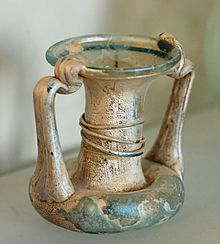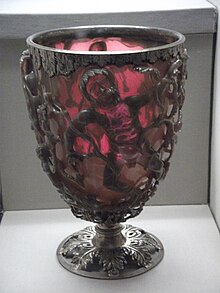
Glass is an amorphous or non-crystalline solid. Because it is often transparent and chemically inert, glass has found widespread practical, technological, and decorative use in window panes, tableware, and optics. Some common objects made of glass like "a glass" of water, "glasses", and a "looking glass", have become named for their material.

Cameo is a method of carving an object such as an engraved gem, item of jewellery or vessel. It nearly always features a raised (positive) relief image; contrast with intaglio, which has a negative image. Originally, and still in discussing historical work, cameo only referred to works where the relief image was of a contrasting colour to the background; this was achieved by carefully carving a piece of material with a flat plane where two contrasting colours met, removing all the first colour except for the image to leave a contrasting background.

Glassblowing is a glassforming technique that involves inflating molten glass into a bubble with the aid of a blowpipe. A person who blows glass is called a glassblower, glassmith, or gaffer. A lampworker manipulates glass with the use of a torch on a smaller scale, such as in producing precision laboratory glassware out of borosilicate glass.
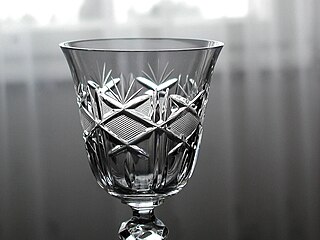
Lead glass, commonly called crystal, is a variety of glass in which lead replaces the calcium content of a typical potash glass. Lead glass contains typically 18–40% lead(II) oxide (PbO), while modern lead crystal, historically also known as flint glass due to the original silica source, contains a minimum of 24% PbO. Lead glass is often desirable for a variety of uses due to its clarity. In marketing terms it is often called crystal glass.
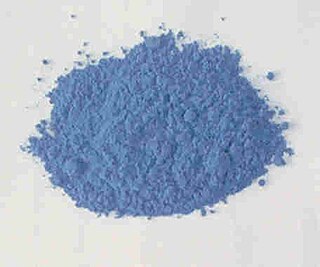
Egyptian blue, also known as calcium copper silicate (CaCuSi4O10 or CaOCuO(SiO2)4 (calcium copper tetrasilicate)) or cuprorivaite, is a pigment that was used in ancient Egypt for thousands of years. It is considered to be the first synthetic pigment. It was known to the Romans by the name caeruleum. After the Roman era, Egyptian blue fell from use and, thereafter, the manner of its creation was forgotten. In modern times, scientists have been able to analyze its chemistry and reconstruct how to make it.

Egyptian faience is a sintered-quartz ceramic material from Ancient Egypt. The sintering process "covered [the material] with a true vitreous coating" as the quartz underwent vitrification, creating a bright lustre of various colours "usually in a transparent blue or green isotropic glass". Its name in the Ancient Egyptian language was tjehenet, and modern archeological terms for it include sintered quartz, glazed frit, and glazed composition. Tjehenet is distinct from the crystalline pigment Egyptian blue, for which it has sometimes incorrectly been used as a synonym.

Anglo-Saxon glass has been found across England during archaeological excavations of both settlement and cemetery sites. Glass in the Anglo-Saxon period was used in the manufacture of a range of objects including vessels, beads, windows and was even used in jewellery. In the 5th century AD with the Roman departure from Britain, there were also considerable changes in the usage of glass. Excavation of Romano-British sites have revealed plentiful amounts of glass but, in contrast, the amount recovered from 5th century and later Anglo-Saxon sites is minuscule.

A cage cup, also vas diatretum, plural diatreta, or "reticulated cup" is a type of luxury late Roman glass vessel, found from roughly the 4th century, and "the pinnacle of Roman achievements in glass-making". Diatreta consist of an inner beaker and an outer cage or shell of decoration that stands out from the body of the cup, to which it is attached by short stems or shanks. About fifty cups or, more often, fragments have survived, and there are only a few in near-complete condition. Most have a cage with circular geometrical patterns, often with an "inscription", or phrase in letters above the reticulated area as well. Some have a flange, or zone of projecting open-cut moulding, above the lower patterns and below the lettering.

Glass casting is the process in which glass objects are cast by directing molten glass into a mould where it solidifies. The technique has been used since the 15th century BCE in both Ancient Egypt and Mesopotamia. Modern cast glass is formed by a variety of processes such as kiln casting or casting into sand, graphite or metal moulds.
The early modern period in England brought on a revival in local glass production. Medieval glass had been limited to the small-scale production of forest glass for window glass and vessels, predominantly in the Weald. The organisation of production evolved from the small-scale family-run glass houses typical of forest glass-making to large monopolies granted by the Crown. The influx of immigrants from Europe brought changes in furnace technology and raw materials, creating a better quality glass. Monastic decrees later banned the use of wood fuel which was then replaced by the less expensive alternative of coal. The development of lead glass in the late 17th century propelled England to the forefront of the glass industry and paved the way for advancements in the Industrial Revolution.

Ancient Chinese glass refers to all types of glass manufactured in China prior to the Qing dynasty (1644–1911). In Chinese history, glass played a peripheral role in arts and crafts, when compared to ceramics and metal work. The limited archaeological distribution and use of glass objects are evidence of the rarity of the material. Literary sources date the first manufacture of glass to the 5th century AD. However, the earliest archaeological evidence for glass manufacture in China comes from the Warring States period.

Forest glass is late medieval glass produced in northwestern and central Europe from approximately 1000–1700 AD using wood ash and sand as the main raw materials and made in factories known as glasshouses in forest areas. It is characterized by a variety of greenish-yellow colors, the earlier products often being of crude design and poor quality, and was used mainly for everyday vessels and increasingly for ecclesiastical stained glass windows. Its composition and manufacture contrast sharply with Roman and pre-Roman glassmaking centered on the Mediterranean and contemporaneous Byzantine and Islamic glass making to the east.

Pottery was produced in enormous quantities in ancient Rome, mostly for utilitarian purposes. It is found all over the former Roman Empire and beyond. Monte Testaccio is a huge waste mound in Rome made almost entirely of broken amphorae used for transporting and storing liquids and other products – in this case probably mostly Spanish olive oil, which was landed nearby, and was the main fuel for lighting, as well as its use in the kitchen and washing in the baths.

Hellenistic glass was glass produced during the Hellenistic period in the Mediterranean, Europe, western Asia and northern Africa. Glassmaking at this time was based on the technological traditions of the Classical antiquity and the Late Bronze Age, but was marked by transition from limited production of luxury objects made for the social elite to mass production of affordable glass vessels used by the broader public to satisfy everyday needs.
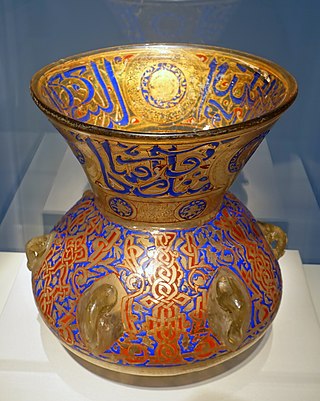
Islamic glass is glass made in the Islamic world, especially in periods up to the 19th century. It built on pre-Islamic cultures in the Middle East, especially ancient Egyptian, Persian and Roman glass, and developed distinct styles, characterized by the introduction of new techniques and the reinterpreting of old traditions. It came under European influence by the end of the Middle Ages, with imports of Venetian glass documented by the late 15th century.

Medieval stained glass is the coloured and painted glass of medieval Europe from the 10th century to the 16th century. For much of this period stained glass windows were the major pictorial art form, particularly in northern France, Germany and England, where windows tended to be larger than in southern Europe. In some countries, such as Sweden and England, only a small number of original stained windows has survived to this day.

Sasanian Glass is the glassware produced between the 3rd and the 7th centuries AD within the limits of the Sasanian Empire of Persia, namely present-day Northern Iraq, Iran and Central Asia. This is a silica-soda-lime glass production characterized by thick glass-blown vessels relatively sober in decoration, avoiding plain colours in favour of transparency and with vessels worked in one piece without over- elaborate amendments. Thus the decoration usually consists of solid and visual motifs from the mould (reliefs), with ribbed and deeply cut facets, although other techniques like trailing and applied motifs were practised.

The ways in which glass was exchanged throughout ancient times is intimately related to its production and is a stepping stone to learning about the economies and interactions of ancient societies. Because of its nature it can be shaped into a variety of forms and as such is found in different archaeological contexts, such as window panes, jewellery, or tableware. This is important because it can inform on how different industries of sections of societies related to each other – both within a cultural region or with foreign societies.

The history of glass-making dates back to at least 3,600 years ago in Mesopotamia. However, most writers claim that they may have been producing copies of glass objects from Egypt. Other archaeological evidence suggests that the first true glass was made in coastal north Syria, Mesopotamia or Egypt. The earliest known glass objects, of the mid 2,000 BCE, were beads, perhaps initially created as the accidental by-products of metal-working (slags) or during the production of faience, a pre-glass vitreous material made by a process similar to glazing. Glass products remained a luxury until the disasters that overtook the late Bronze Age civilizations seemingly brought glass-making to a halt.
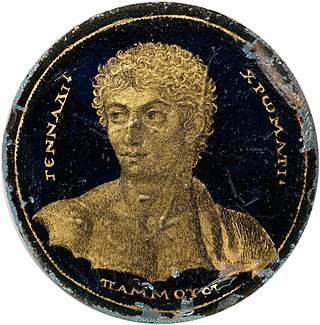
Gold glass or gold sandwich glass is a luxury form of glass where a decorative design in gold leaf is fused between two layers of glass. First found in Hellenistic Greece, it is especially characteristic of the Roman glass of the Late Empire in the 3rd and 4th century AD, where the gold decorated roundels of cups and other vessels were often cut out of the piece they had originally decorated and cemented to the walls of the catacombs of Rome as grave markers for the small recesses where bodies were buried. About 500 pieces of gold glass used in this way have been recovered. Complete vessels are far rarer. Many show religious imagery from Christianity, traditional Greco-Roman religion and its various cultic developments, and in a few examples Judaism. Others show portraits of their owners, and the finest are "among the most vivid portraits to survive from Early Christian times. They stare out at us with an extraordinary stern and melancholy intensity". From the 1st century AD the technique was also used for the gold colour in mosaics.
